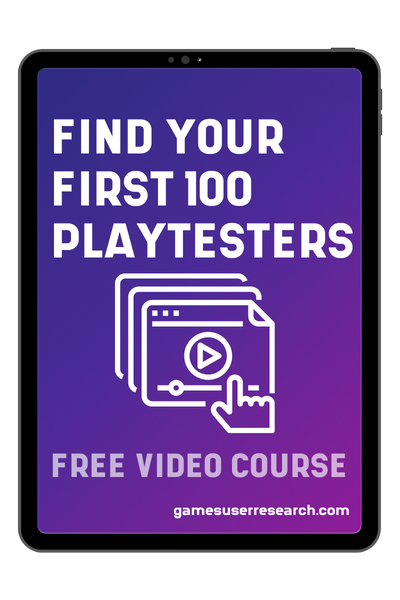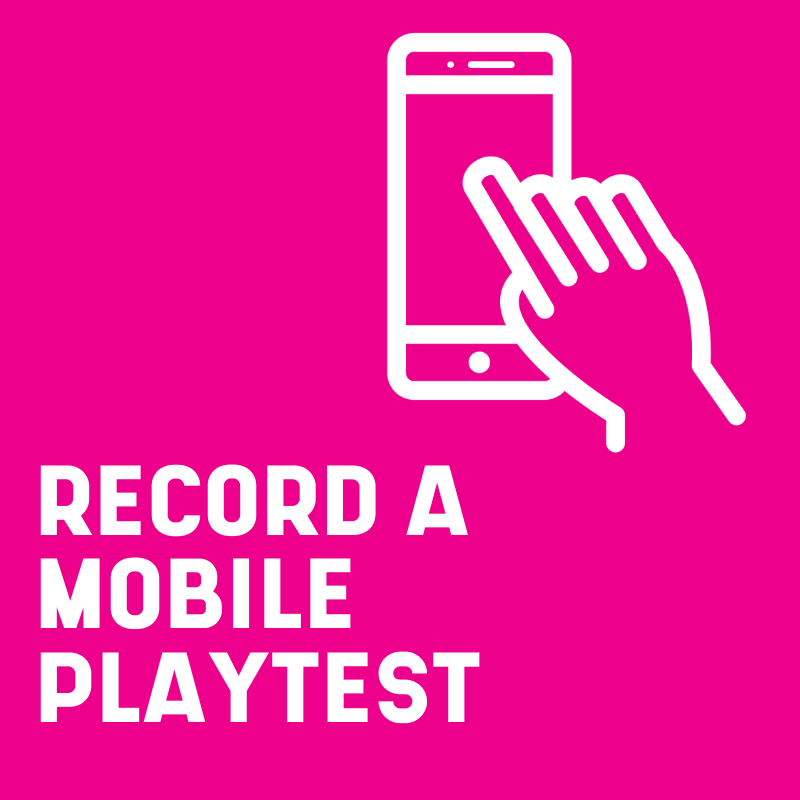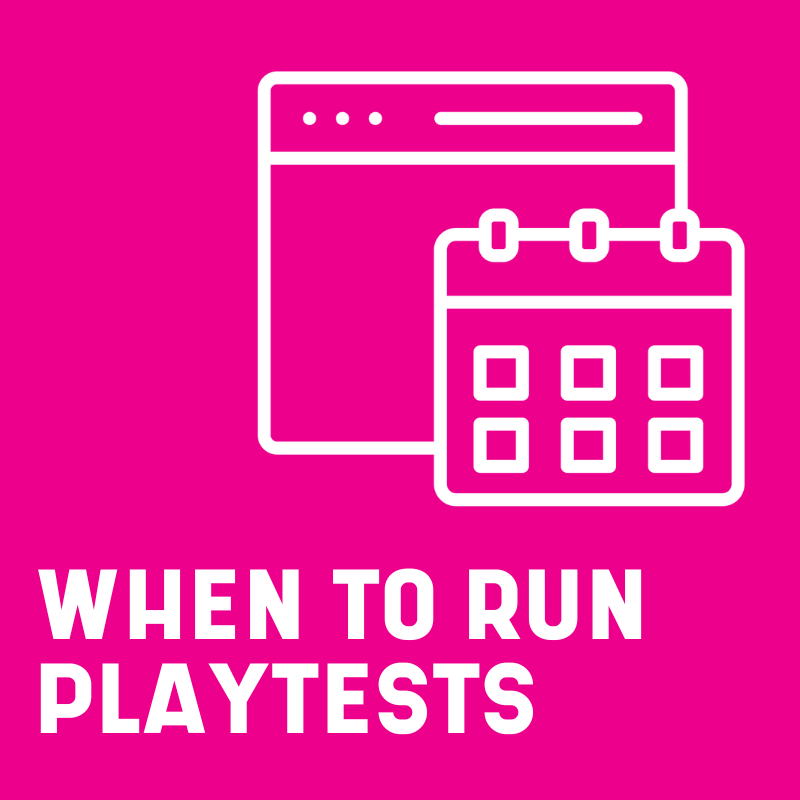Playtesting is an essential part of the game development process. The data from player’s behaviour and opinions are rocket fuel for iteration – and iteration makes great games. But it’s hard to find people who are willing to give up their time to play your game, and give high-quality feedback.
In this post, we’ll cover how and where to find good quality playtesters, and how to make regular playtest recruitment quick & efficient.
By the end of this article you will have created a panel of playtesters you can call upon to take part in your playtests.
New: Get my video course to find your first 100 playtesters FOR FREE
Due to the high level of interest in this blog post, I have created a course with all of the templates and processes game developers need to define, find and capture genuine playtesters.
Sign up to get access to the course for free (worth $29), and monthly emails from me with games user research how-to guides to help you run unbiased and useful playtests.

Its hard to find good playtesters
If you look at game development forums, the topic of finding playtesters comes up time and time again.
“I was wondering if you guys could give me some advice on where to find playtesters and how to get as much useful info from them as possible.”
“should I just start randomly messaging people?”
“I’m looking to find groups without me in them to play it. Finding them has proven tricky, so I was wondering if there’s any advice or specific places I should be looking?”
“But how do you get strangers on the internet to play your demo and tell you what they thought of it?”
“We have no idea as to where to find trustful people to playtest our game and give meaningful notes about it”
We all recognise the value of running playtests. But finding playtesters is hassle. It takes a bunch of time (which we no-one has). And then playtesters drop out, after wasting a bunch of your time. Or they give feedback that isn’t relevant.
Ultimately this means that playtesting becomes too much hassle, and without a clear return on investment, we prioritise other development tasks instead.
This means we miss the value of playtests. Playtests uncover problems with prototypes, reveal what people’s opinions of the game currently are, and allow us to make changes to improve the quality of the game before launch. But game developers are often stuck, and don’t know where to find playtesters, or how to convince them to take part.
Some playtesters are not helpful
Some of the advice given on game development forums is bad. Typical advice includes “Ask your friends to play”, “Why not post it in the game development forum”, “You can show it at trade shows”.
It’s understandable why we consider these groups – they are cheap (apart from trade shows!), and convenient – full of people who are more likely to give up their time to playtest for free.
However the feedback from these groups is unlikely to be helpful.
Your friends are too nice – they don’t want to hurt your feelings. And even if they can overcome that to say negative things, they are unlikely to be the target audience for your game. Take it from anyone who has ever released a game – your friends will say “that’s lovely”, “well done”, but are not the people who will actually pay money to play your game on launch.
Game developers, and trade show attendees, are much more ‘hardcore’ than the typical audience, and won’t show the same behaviour or opinions as your real player. Balancing your game, or changing it based on their feedback, will drag it further away from being accessible or enjoyed by your real players.
Both these groups will give you feedback, sure. But the feedback, and data gathered from their playtests will be a lot less useful than that from your real players.
In user research terms, this is called a ‘sampling issue’. You are getting feedback from a different group of people than your real players, and so the data you are gathering is not safe to draw conclusions from. This can make your playtesting a waste of time.
A simple process for recruiting playtesters
Luckily, this is a solved problem. Game studios know they need to run regular playtests, and have developed processes for finding, keeping and using playtesters, without spending a huge amount of time or money on it.
This is the playtest recruitment process, and the steps we will go through are:
- Define your target player
- Create a place to hold them
- Offer the right incentive
- Finding their communities
- Write a compelling pitch
At the end of this process, you will have a group of primed and suitable playtesters, ready to participate in your playtests.
The best part is, a lot of this pre-work only has to be done once – after going through the steps you will always have a pre-established group of suitable playtesters whenever you need to call upon them for future playtests.
1. Define your target player
We heard above about sampling bias – getting the wrong playtesters. Finding representative players is the most important part of organising a playtest – testing with randoms gets feedback that may not match your final audience.
Before we can find them, we need to decide ‘who are our target players’. Let’s consider what we know about them already:
👉 We know your target player will play your game 👈
That’s enough to get started.
We can assume if they are going to play your game, they are likely to play other similar games. That gives us something we can build on.
Start by thinking out other games that you’d expect someone who buys your game to play. They can be in a similar genre, or share a similar vibe. Think about where you intend to sell your games – if you are distributing it via itch.io, your players are likely to play other games from itch.io.
Use this to write a list out all of the games your players could also be playing, that are similar in scope to yours (ignore the big ones that ‘everyone plays’ like Fortnite, Call of Duty or FIFA unless you share their marketing budget).
That list could look like this:
Then for each of those games, write a short description of why you included it:
These descriptions can reveal themes, that we will use to describe our target player.
In most cases, what we don’t know about our players is any demographic information – their age, gender, race etc. And that’s ok, because we don’t need to know their demographics to find them. In general, demographic information isn’t that useful for playtesting or UX research, because it’s a lot less predictive of whether they will buy your game than whether they have bought similar games before.
The exception to this is games that are specifically made exclusively for one demographic – for example childrens games. In those cases, do focus on playtesting with children!
On our first go at this, defining the target player can feel a bit vague, or like you are guessing. Don’t worry! Our definition of our target player will change over time, and it’s ok if some parts aren’t perfect.
When running playtests, speak to players about what other games they play (or don’t play), how they decide to buy games, and where they discuss games or look for help when stuck. This will reveal both new information we can use to refine our definition of our target player, and new communities that we can advertise for playtesters within (coming up in step 4!).
You can capture this information about your players on a profile, that you build up and adapt over time as you learn more about your players, like this:
🚀 Do this now – Write your first draft of your player definition.
2. Create a place to hold them
It’s a lot of effort to recruit playtesters. This means we want to maximise the value of each recruitment effort. Instead of recruiting just for a single playtest, we want to get as many people to agree that we can call on them in the future. This is called ‘a panel’ in UX research.
We will still have to re-recruit in the future, as we’ll need new players when these playtesters get used up, and people’s likelihood to take part decreases the longer we wait after recruiting them to use them. But this approach maximises the value of each individual recruitment drive.
We’ll need a place to keep these future playtesters. My recommendation is to create an email mailing list, and store them there.
With email we can reliably know that when you send out an invite to take part in a playtest, people will receive it. (It also allows us to track how effective our invites are at being opened)
Other alternatives (such as a facebook group, or having them as twitter followers) are subject to the whims of ‘the algorithm’ which often decides not to show your posts to your followers. Discord channels are also fine, but many people are subscribed to lots of discord channels, and miss updates in some of their less frequently used ones. This makes them less effective for storing your playtesters than a mailing list, which you know they will be getting into their inbox.
Mailchimp is a mailing list tool, which is free until you reach 2,000 subscribers – so can be a good place to start. Convertkit is another popular alternative, free for the first 1,000 subscribers. These tools are better than just emailing people directly, or keeping a spreadsheet, because they handle a lot of the responsibilities for holding personal data without you having to deal with it yourself.
Both Mailchimp and Convertkit allow you to create a landing page, where you can direct playtesters and ask them to sign up to your playtest mailing list.
🚀 Do this now – Sign up for an account on Mailchimp or Convert Kit, and make your landing page
3. Offer the right incentive
People don’t do anything for nothing. Your friends and peers will playtest because of the social connection they have to you. But other players don’t know you. And as we’ve covered, we want to attract more ‘typical’ people, outside of your current circle.
This means we need to offer them something. Teams with a budget offer money (or things equivalent to money, like Amazon vouchers). This is the best thing to offer, because money is useful to almost everyone it introduces minimal bias.
Not every team has the budget to offer money, which is understandable. One alternative is to offer codes for games. I’ve seen lots of teams have success by partnering with other indie developers to create a shared catalogue of potential game codes, and allowing the player to pick a code for any of them. By letting them pick from a variety of games, you minimise the bias introduced by the type of game offered (and you can reciprocate with giving codes for the other studio’s playtests)
You can also consider offering in-game rewards or recognition – a ‘thank you’ credit, a character named after them, a bespoke Discord role, or a personal update after the playtest. This is fine, but introduces the largest bias to your group of playtesters – only people who care about credits or recognition will apply.
Regardless of what you pick as an incentive, you need to offer something. Think about how what you offer will influence who decides to sign up, and keep that in mind when deciding on your incentive.
🚀 Do this now – Contact a peer game developer and ask about sharing codes. Decide your incentive.
4. Find their communities
Now we need to find where these players hang out online. Because we’ve defined what other games they play, that gives us a clue of where to look.
Look at your list of other games your target players play, and pick one that is similar to your game as your first target game.
Google <<target game>> + some other search terms, such as “forum”, “help”, “question”, “support”, “community”. You’re looking for places where people are talking about the target game, and other similar games.
A good sign is a forum where people are asking for help (so try “stuck” as a term too). These questions show that these are places that ‘typical’ players come to, and are very likely to be the type of person your own game is pitched at.
Make a list of all of the forums and communities you discover. You’ll need them soon!
This process can be repeated for each of your target games, and you’re aiming to end up with at least ten communities on your list. You can keep on going and find more later, after you’ve had some success with these, but don’t get stuck on this step. Just do enough research now to allow you to continue.
🚀 Do this now – Run the google search for your audience, and shortlist ten communities you are going to target.
5. Write a compelling pitch
Lastly, we need to write a compelling pitch that convinces the people in these forums to sign up to take part in your playtest. As covered, people don’t do anything for nothing – so remember to emphasise the incentive, and make it clear what’s unique about your game.
Spending time to craft a unique and well-written post, in the style of the forum you are posting in will be essential to avoid coming across as spam. Here are some tips:
- Lead with the USP of your game – what makes your game different to every other game
- Describe why you think the game is relevant to them (remember, you have picked this forum because of their interest in a similar game, so mention the shared interests)
- Mention the reward for taking part in playtests
- Explain that signing up to the mailing list is just for playtest invites, and you won’t be spamming them.
Rather than spamming your post in all of the communities you found immediately, post in one, and take time to look at the feedback and questions from your first post. Use the communities reaction to iteratively update your post for the next community. This will help create more convincing posts.
On this playtesting post, don’t send them to your discord, twitter, or mix it with other marketing channels. Those are distractions, and today we just want them to give you their email for playtesting, so you can contact them again.Most mailing list tools allow you to create an automated welcome message once they sign up, if you want to make them aware of your other channels too.
Post your first message to one of the communities you found. Then learn from the experience and repeat with the next community. Then keep going!
🚀 Do this now – Post the message, and see your response rate.
You now have a pool of warm playtesters
Everyone who signs up to your playtest mailing list will be ready to take part in playtests. You can then send the whole mailing list an email when you want to run your playtest, and the response rate will be higher than any other channel.
Because you found all of your players via your target games, you know these will be high-quality playtesters, who are relevant to your audience.
When you need to grow your list, you also have a process for that – jump back to step 4 and repeat for the next target game, or carry on googling to uncover the next set of forums and communities. The internet is large, and there are always more forums where people are talking about similar games – we just need to find them.
This is just the first step for making the most of your playtesting. To learn how to use them once you have them, sign up to get a monthly playtesting lesson just like this direct into your inbox at the bottom of the page.
Continue growing your playtest skills
Every month I send a playtesting and games user research lesson, just like this one, to help game developers run better playtests. Sign up to my mailing list to get a monthly playtesting lesson straight into your inbox.
Happy playtesting!
Integrate player insight throughout development
Every month, get sent the latest article on how to plan and run efficient high quality playtests to de-risk game development. And get Steve Bromley’s free course today on how to get your first 100 playtesters for teams without much budget or time.
Plus your free early-access copy of ‘Playtest Plus’ – the essential guide to the most impactful playtests to run throughout development of your game



